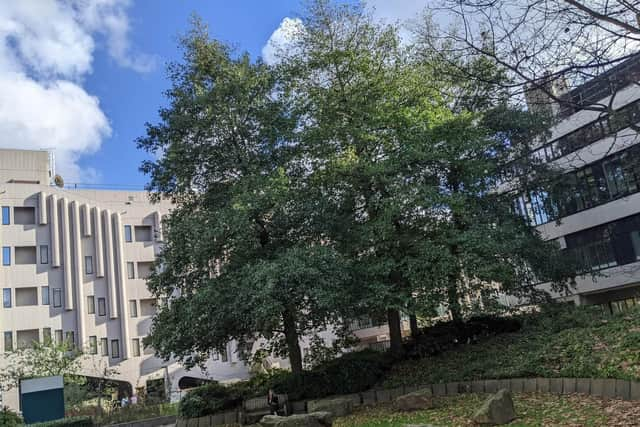Leeds innovation arc: Major plans unveiled to regenerate old buildings and create new neighbourhoods in city
and live on Freeview channel 276
There is St Paul’s House on Park Square, which was built in the 1870s as a warehouse for the Victorian industrialist and Leeds MP John Barran.
There is the old medical school on Great George Street, where healthcare students learnt their trade for decades.
Advertisement
Hide AdAdvertisement
Hide AdThe belt runs down the spine of the city’s centre west, stretching from Wellington Place all the way up to the sprawl of campus buildings belonging to the University of Leeds on the edge of Hyde Park.


This stretch of land is what city leaders have christened Leeds’ innovation arc – a scheme to regenerate old buildings, create new neighbourhoods and attract new tech businesses and jobs over the next decade.
“The tech sector always has this impression that it’s boffins sat on bean bags in California, but this can be a huge opportunity for Leeds to be part of that industry,” city council leader James Lewis says.
“We have a workforce of about 400,000 people in Leeds and 10 per cent are employed in tech and start up businesses.
Advertisement
Hide AdAdvertisement
Hide Ad“So this is a very clear vision to grow that section of the economy.”
The NHS, with Leeds General Infirmary on the arc’s footprint, and the University of Leeds itself, are also involved in trying to repurpose old buildings for new times.
“The council, the NHS and the university can each apply our own strengths to a very exciting economic project,” Councillor Lewis adds.
“The innovation arc is not a new idea and we’re not the only city doing it.
Advertisement
Hide AdAdvertisement
Hide Ad“But we’re starting off with the institutions we’ve got and we’re looking at what’s the right development on the western side of the city centre.
“We know increasingly the city centre is becoming residential, as well as (being focused around) work and retail.”
It’s this part of the scheme particularly that excites geographer Rachael Unsworth, who’s recently led a series of walking tours around the arc for developers, architects, amateur historians and members of the public.
Around 3,000 new homes are expected to be created across the arc over the next 10 years, while green and public space is also a priority, with two new parks on the way.
Advertisement
Hide AdAdvertisement
Hide AdRachael hopes the plans will reignite a sense of community among people living in the city centre.
“We need to encourage that kind of engagement with your local area,” she explains.
“Now the cat is out of the bag with working from home, it means people now really care more about the quality of where they live.
“It’s not just about economic growth. It’s about creating places where people want to be and being able to generate ideas and creativity – both in the work sphere and the physical environment.”
Advertisement
Hide AdAdvertisement
Hide AdCouncillor Lewis says that the city centre needs to be “much more friendly for people to get around it and be less dominated by roads and traffic”.
“During lockdown we saw how much people valued green space near where they live,” he adds.
“We know some of the areas around the city centre are among the poorest in the city, so this is about really making it easy for people to get in and for it to be accessible.”
But as grand as these plans are, can they be delivered in a recession?
Advertisement
Hide AdAdvertisement
Hide AdThe economic crash of the late 2000s saw the construction industry suffer across the UK, developments left half-completed and some buildings turn into public eyesores.
Councillor Lewis remains undeterred.
“At the moment we’ve got really strong investor confidence in Leeds and we’re seeing some really exciting schemes coming forward,” he says.
“There are lots of cranes on the skyline in Leeds at the moment which I think reflect that confidence in Leeds.
“It’s always a worry when a recession comes along about some of the pace of development, but this won’t be develivered over one or two years. This is setting the framework for development over the next 10 years.”
Advertisement
Hide AdAdvertisement
Hide AdFor Rachael Unsworth, she hopes the plans rekindle the spirit of John Barran, who besides being in big 19th century business is widely regarded for his generosity and philanthropy work.
According to local history group The Thoresby Society, he was a founder governor of the Yorkshire College, which later became Leeds University, as well as being a Liberal MP for Leeds and later, Otley.
His cloth warehouse also had a reputation for good working conditions and pay, in a century few such workplaces did.
“The era is so long in the past of people being in big business but being represented in the civic sphere as well,” Rachael says.
Advertisement
Hide AdAdvertisement
Hide Ad“There was a huge amount wrong with Victorian Leeds in terms of the huge discrepancy in wealth and lifestyles, but that work done by institutions was a hallmark of the time.
“We need to encourage more of that.”
